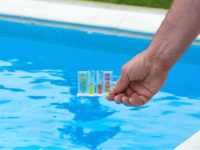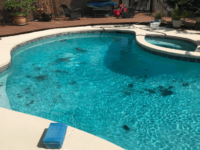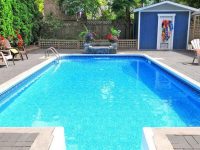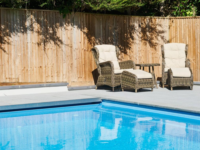You have heard about pool flocculant as a magical tool that turns the cloudy pool into crystal clean.
Well, the good news is that it really can. However, you need to use it properly, or you will pay with your time and money. We are here to assist you and prevent you from doing typical mistakes.
Before using you should check the relevant situations to use a pool flocculant. If it is your case, go to the 6 steps to get the clean pool with the flocculant.
What is a pool flocculant
The pool flocculant clumps fine particles in the water together until they are large enough to sink to the bottom.
You have cloudy water because there are many unsoluble particles in the pool. They are too small, so the filter cannot capture them as well they cannot settle down without assistants. There the flocculant enters the game to help pool owners to capture those pollutants.
Flocculant vs clarifier
The “flocculant” and the “clarifier” are usually mixed up. Although both are pool cleaners, they are completely different. The below table states the main differences.
| Flocculant | Clarifier | |
| Mechanism | Coagulate fine particles and then sink them to the bottom to remove through vacuuming | Concentrats small particles into bigger chunks to get caught by the filter |
| Cleaning speed | 8-24 h | 2-3 days |
| Additional actions to clean the water | Yes, you need to manually vacuum “to waste” the debris from the bottom | No, just pour the clarifier into the pool |
| Compartability with all equipment | You cannot use the floc with cartridge filter | Suitable for all kinds of equipment |
When to use a pool flocculant?
Flocculant is not a “magic pill” while resolving all issues with cloudy water. In most cases, a balanced pool with proper filtration is enough for cleaning the pool. If you had mild cloudiness and several extra days, you might also use a clarifier to help you. However, there are some situations when flocculant is the best solution.
🏊 You need a clean pool in a day
Compared to the clarifier the flocculant starts working immediately. It takes 12-24 hours to coagulate particles and sink them to the bottom. Then you can vacuum them from the pool.
☁️ The pool is very cloudy
After shocking, a green pool you might get cloudy water. If you don’t have enough time waiting until the filter does its job, the flocculant is an option too.
🔥 Clean the pool from ashes after wildfire or dirt after the storm
In this situation, the floc is the best possible option to make the water clean.
Step-by-step guide on how effectively use the pool flocculant

When considering using flocculant, you need to know a simple sequence of steps and follow them strictly. It will help you to achieve the best possible results. You might also check the section about common issues with flocculant use and their troubleshooting.
If the pool is cloudy
Cloudy water is the most popular reason for using flocculant for the pool. Be prepared, it is a responsible procedure.
1. Raise the water level
While vacuuming the waste the water will decrease significantly. Fill it to the maximum level.
Check the article on how to treat cloudy water without flocculant.
2. Balance the pool
Test the water, and adjust the pH to 7.4-7.6. The rest of the parameters should be in the standard range. The flocculant lowers the pH level, and you should maintain the right pH during treatment to prevent microorganisms from growing.
📌 Tip! Selecting a proper testing system is important for maintaining pool health. We recommend you read an expert review on top of the most popular testing kits on the market
3. Add the floc
The way of adding varies depending on the flocculant form: liquid, tablets, or cartridge. Attentively read the manufacturer’s instructions about dosing and distribution on the bottle. Stricly follow them.
4. Turn on the pump for a one-two hours
Set the pump to the “recirculation” to evenly distribute the flocculant in the water.
📌Tip! Set a timer or notification about turning off the pump after the time pass. Otherwise, the flocculant will clog up the filter.
5. Turn off the pump and leave for 8-24 hours
The particles will form clots and settle down on the bottom.
6. Vacuum the pool
Turn on the pump and set the filter “to waste”. Vacuum the bottom manually at a low speed. You should work thoughtfully and slowly in cleaning to avoid stirring up the debris. If you do, you will need to take a break to allow everything to settle down again.
It will take you two or three times vacuuming to remove all the debris. After the first time, allow debris to sink again and repeat the procedure to get more clean water.
❗AGAIN! You should vacuum only “to waste”, otherwise, the debris will clog up the filter
Tip! The water level will decrease during vacuuming. You might put a hose into the pool and turn on the water to maintain the water level. If the level drops to the half-height of the skimmer the air will enter the pumping system. It will cause issues for a working pump.
7. Rebalance the pool
Set the valve to the “filter” mode and balance the pool. Turn on the pump and run it for the next 24 hours to remove all floc residues and get crystal clear water.
If the pool is green
Green water means that you have algae in the pool. First of all, shock the pool to kill all algae. The flocculant does not affect living algae. The presence of living algae in the pool is the most common reason when people complain about ineffective flocculant.
After killing all algae, go through steps 1-7 for the cloudy pool.
📌 Tip! If you considering using algaecide, read the step-by-step guide on how to safely use it.
Mistakes to avoid
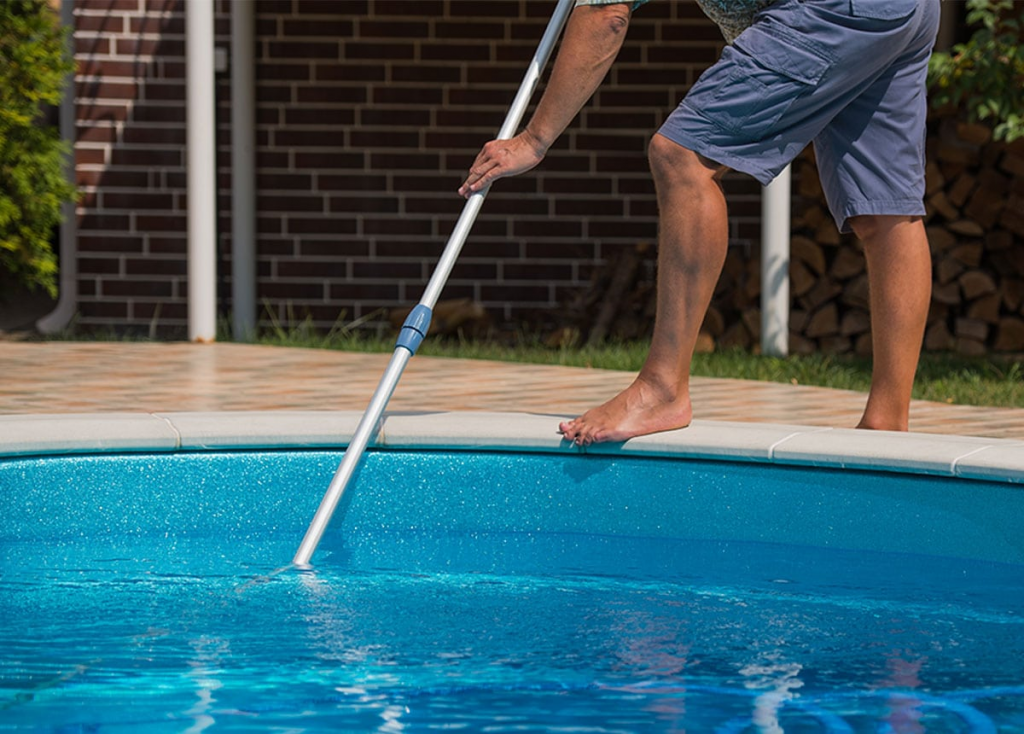
❌ Robotic vacuum cleaner
While a pool robot is a great time and effort-saver for everyday care, the use of flocculant is not that case. Robots agitate the water, so the debris disperses again. You should slowly clean debris manually “on waste” and avoid disturbing and returning clots to the pool.
❌ Don’t set the vacuum “to waste”
Firstly, it will gum up filter media. If it happens, the sand and diatomaceous earth (DE) filters will require major cleaning afterward. Secondly, bondings between particles don’t last forever. While trapped in the filter they will break down throughout the time. The water stream will wash them away and release them into the pool. As a result, you will see the cloudy water again.
❌ Use flocculant without treating live algae
Using floc before removing algae is a waste of time and money. The flocculant cannot care about live algae. If your pool is green, you should kill algae with pool shocking or with algaecide before using flocculant. Otherwise, the pool remains cloudy.
❌ Don’t discover the cause of the cloudy water
The flocculant is a quick solution to cloudy water, however, it does not fix the reason. You should discover what causes the accumulation of fine particles in the water. Then address the issue properly and avoid the situation in the future.
Common issues and troubleshooting
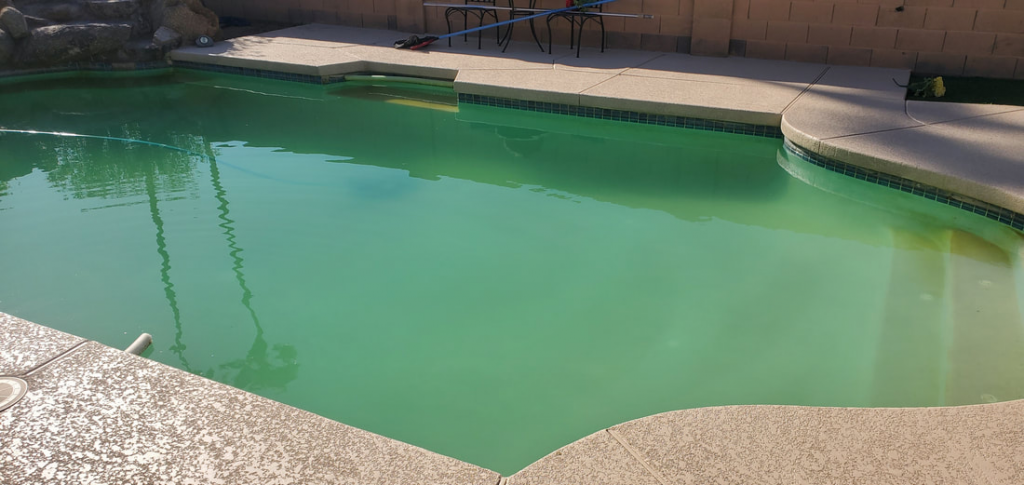
While used incorrectly, the flocculant becomes a disaster. In this section, we propose some common troubles some users got, while using flocculant and how to properly address them.
🔷 The water is still pretty cloudy after the flocculant
If you see that the floc is not settled, see the next section. There is also a situation when the floc doesn’t clean the cloudy water. It can be due to several reasons:
- You didn’t kill all the algae
- Issues with filter
- Unbalanced water
Try to do the following:
- Vacuum “to waste” everything that has already settled
- Find the primary reason for the cloudy water and address it properly
🔷 The flocculant did not sink
There are a couple of reasons for this:
- You didn’t wait for enough
- You didn’t kill all algae
- The pump was running.
Try to do the following
- Wait up to 48 hours (sometimes more) with the pump turned off
- Vacuum “to waste” everything that has already settled
- If you still have a floc in the water, turn on the filter and catch as much floc as possible. Backwash it frequently to avoid clogging
🔷 Floc gets into the filter
Depending on the filter type you might need to clean or replace it:
- Sand filter: try to backwash the filter. If it does not help, change the sand
- Cartridge: replace the cartridge
- Diatomaceous earth (DE) filter: open and clean the grids
🔷 Overdosed flocculant
While overdosed the floc causes the opposite effect and the pool turns into a cloudy mess. The solution in such a situation is simple:
- Turn off the pump for 24 hours and allow everything to settle
- Vacuum to waste everything you can
- Refill the pool with fresh water
- Repeat the process over and over again until all flocculant is gone
🔷 The filter does not have a “drain to waste” option
Well, it is not a rare situation. Be attentive to the instruction the next time. You cannot remove the floc with any other option than vacuuming. In such a situation you should do one of the following:
✅ Try to remove the cartridge from the filter canister. Turn the pump on and vacuum the pool. After removing all the debris, turn off the pump, set the filter back, and start filtration
✅ Get a transfer pump and vacuum the pool with it.
Summary
The flocculant is not a chemical of the first aid while dealing with cloudy water. It has a limited number of situations when you should use it. Firstly, you urgently need a clean pool just in a day. Secondly, while fighting the consequences of the natural disaster, when many particles get into the pool, for example, ashes or dust.
The flocculant does not treat algae, so you need to kill it first and then remove cloudiness with the flocculant.
While using you should strictly follow the instruction on the bottle. The most critical steps are (1) turning on the pump for 1-2 hours to distribute the floc and (2) setting the filter “to waste” while manually vacuuming. You should always ensure that the filter has the option “to waste” before adding the floc. Controlling over these steps will prevent you from most issues and save you much money, nerves, and time.
FAQ
⏱️ How long can I let a pool flocculant do its thing?
It takes from 8 to 24 hours for the flocculant to coagulate and settle down the particles. If the flocs are not on the bottom after the time pass, you might wait for another 24 hours.
⌛ How much time to wait after flocculant before swimming in the pool?
Flocculant works effectively in the still water, otherwise, the particles wouldn’t clump together. After the debris sets down, you should vacuum it out to waste. As soon as you remove all the debris and balance the pool is ready to swim again.
🤖 Can I use a robotic cleaner to vacuum the floc?
It is not recommended. The robot creates a lot of agitation around and clouds the floc up. The best way to remove the floc is to vacuum to waste manually and slowly. You should prevent any additional movements.
👀 Why set the pump to waste when using the flocculant?
If the flocculant enters the filter, it will glue up the filter media and decrease its efficiency. Moreover, the bonds between particles don’t last forever. While stuck in the filter, the particles will release over time and enter the pool again. The cloudy water will return.
😏 Can I use pool flocculant with cartridge filter?
No. The systems with cartridge filters do not have the “to waste” option. The flocculant gums up the filter and you will buy new cartridges to change until filtering out all flocculant.
😔 How much flocculant does it take to clog cartridges?
Once you add the full portion of floc into the pool it is enough to clog at least one cartridge. However, you might need more cartridges to vacuum all the flocculant from the pool.

